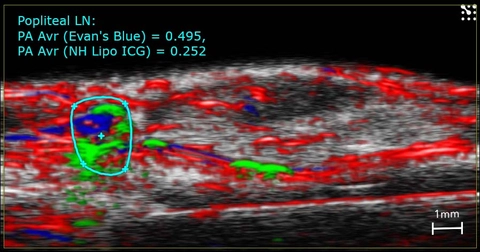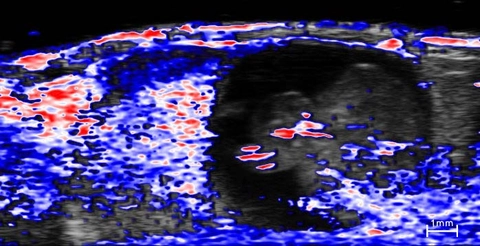
Perfusion in Tumor

High-resolution ultrasound (left) and nonlinear contrast (right) image of a subcutaneous tumor showing perfusion in the tumor tissue.

Blood flow in tumor


Perfusion in Tumor

3D rendered high-resolution nonlinear contrast image of a subcutaneous tumor showing perfusion in the tumor tissue.

Blood flow in tumor

3D rendered high-resolution ultrasound (greyscale) and color Doppler (orange and blue) image of a subcutaneous tumor showing blood flow.

Nanoparticle distribution in tumor

3D rendered high-resolution ultrasound (greyscale) and spectrally unmixed photoacoustic (red, blue and gold) image of a subcutaneous tumor showing nanoparticle distribution (yellow) as well as oxygenated (red) and deoxygenated (blue) hemoglobin signal.

Imaging of lymphatics in the mouse.

High-resolution ultrasound (greyscale) and photoacoustic (red, blue and green) image of the mouse hindlimb showing Evan's Blue (blue) and ICG (green) dye in the lymphatic vessels and the popliteal lymph node.

Stem cells in the mouse hindlimb

3D rendered spectrally unmixed photoacoustic image of a stem-cell injected, ischemic (right) and control (left) mouse hindlimb. Oxyhemoglobin (red), deoxyhemoglobin (blue) and dye-labelled stem cells (green) are shown.

Screenshot of mouse brain atlas

Screenshot of the Vevo LAB software displaying several different views of the CD-1 mouse brain atlas which comes with the Vevo BRAIN stereotactic frame.

Neuroanatomy of the mouse brain

3D rendered surface view of the mouse brain segmented by anatomical region based on ex vivo high frequency ultrasound images.

Mouse ear vasculature

3D rendered coregistered ultrasound (greyscale) and photoacoustic (red) image of the mouse ear. The photoacoustic signal is derived from the absorption of light by hemoglobin.

Ischemia/hypoxia stroke model

Plot of oxygen saturation (sO2) over time in the left (pink) and right (orange) cortical and subcortical hemisphere ROIs while restoring breathed oxygen to 100% from 7.5% post ischemia/hypoxia for stroke induction. Ultrasound (top) and photoacoustic (bottom) coronal images in the right panel show a frame of mouse brain post ischemia/hypoxia. The red, white and blue color represents a parametric map of oxygen saturation. The right hemisphere does not fully recover sO2 levels post-reperfusion/normoxia that are shown in the left hemisphere, indicating a cerebral infarct, especially in cortical and subcortical areas.

Ischemia/hypoxia stroke model

Ultrasound (left) and photoacoustic (right) coronal images of a mouse brain post ischemia/hypoxia. The red, white and blue color represents a parametric map of oxygen saturation. The right hemisphere does not fully recover sO2 levels post-reperfusion/normoxia that are shown in the left hemisphere, indicating a cerebral infarct, especially in cortical and subcortical areas.

Mouse hindlimb post-reperfusion

3D rendered power Doppler image of the mouse hindlimb showing blood flow. Application of a tourniquet made of tubing was used to restrict blood flow into the distal part of the limb, then relieved to allow reperfusion.

Mouse hindlimb post-reperfusion

3D rendered photoacoustic image of the mouse hindlimb showing a parametric map of oxygen saturation with red denoting higher sO2 values. Application of a tourniquet made of tubing was used to restrict blood flow into the distal part of the limb, then relieved to allow reperfusion. Higher sO2 is seen in the distal part of the limb post-reperfusion.

Mouse hindlimb during ischemia

3D rendered photoacoustic image of the mouse hindlimb showing a parametric map of oxygen saturation with red denoting higher sO2 values. Application of a tourniquet made of tubing was used to restrict blood flow into the distal part of the limb. Much lower sO2 is seen in the distal part of the limb during this acute ischemia.

Mouse hindlimb with tourniquet

3D rendered high-resolution ultrasound image of the mouse hindlimb showing a depression in the skin from a tourniquet made of tubing being used to restrict blood flow into the distal part of the limb.

Oxygen saturation in E14 mouse embryo and placenta

In vivo co-registered high-resolution ultrasound (greyscale) and photoacoustic (red, white and blue) image of an E14 embryo and its associated placenta (on left of each image). The photoacoustic signal represents a parametric map of oxygen saturation with red values representing higher sO2. The image was acquired while the mother was breathing medical air (20% O2). Oxygen saturation can be distinguished within differing placental and embryonic anatomy.

Oxygen saturation in E14 mouse embryo and placenta

In vivo high-resolution ultrasound (left) and photoacoustic (right) image of an E14 embryo and its associated placenta (on left of each image). The photoacoustic signal represents a parametric map of oxygen saturation with red values representing higher sO2. The image was acquired while the mother was breathing medical air (20% O2). Placental and embryonic anatomy can be distinguished.

Oxygen saturation in E14 mouse embryo and placenta

In vivo 3D rendered co-registered high-resolution ultrasound (greyscale) and photoacoustic (red, white and blue) image of an E14 embryo and its associated placenta (on left). The photoacoustic signal represents a parametric map of oxygen saturation with red values representing higher sO2. The image was acquired while the mother was breathing medical air (20% O2).

Oxygen saturation in E14 mouse embryo and placenta

In vivo 3D rendered co-registered high-resolution ultrasound (greyscale) and photoacoustic (red, white and blue) image of an E14 embryo and its associated placenta (on left). The photoacoustic signal represents a parametric map of oxygen saturation with red values representing higher sO2. The image was acquired while the mother was breathing 100% oxygen.

E14 mouse embryo

In vivo 3D rendered co-registered high-resolution ultrasound (greyscale) and photoacoustic (red) image of an E14 embryo and its associated placenta (on left). The photoacoustic signal was acquired at 750nm and represents signal from mostly deoxygenated hemoglobin.